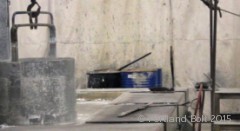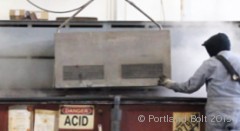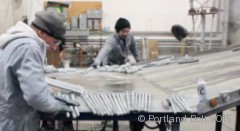Depending on which configuration of pole line fastener you are inquiring about, various manufacturing procedures are involved with producing the finished product. Not all pole line fasteners follow the same manufacturing steps, so we have specified which types are common to each process.
Cutting
The first step in manufacturing any pole line fastener is to cut the steel to the appropriate length. This is true for both headed bolts as well as rods. The raw material, which is hot rolled into straight lengths measured at 20 feet, will need to be either sheared or saw cut to the appropriate length. The cut lengths will vary since headed bolts require the material to be slightly longer for the forging of the head and rods (as well as headed bolts) need to be longer than the specified length to compensate for the added semi-cone point.
Heading
Once the steel has been cut to the appropriate length, it is time to forge the head onto one end of the bolt. In a hot forging process, one end of the steel rod is heated up in an induction unit before feeding into a National Upsetter used to forge the head onto the bolt. The purpose of this is to make the steel more malleable so that it can be formed easily. A plunger compresses the heated steel to form the head of the bolt as well as the required grade stamp and manufacturer’s marking, which is displayed on the top surface of the bolt head. Common pole line fasteners with forged heads are square head machine bolts, hex head machine bolts, washer head bolts, and clamp rods.
Pointing
Pole Line Fasteners require a semi-cone point added to the threaded end to allow easy installation of the fastener through the wood members. The pointing is normally performed before the threading operation. The point is not included in the bolt length call-out and is added to headed bolts as well as both ends of double-end rods or double arming bolts.
Threading
After the pointing is complete the bolts are threaded. The threaded portion is produced by either cut threading or roll threading. Cut threading is a method where the steel is actually cut away from the full-size bar to form the threads. Roll threading is an extrusion process in which two dies form the threaded portion of a fastener by forcing the steel bar between them. To achieve the full dimensions of the thread, a reduced diameter round bar is used. For example, a 3/4″ diameter bolt is manufactured from a .680″ diameter round bar. This is referred to as “pitch diameter” round bar and is approximately the midpoint between the major diameter (peaks) and minor diameter (valleys) of the threads. The pitch diameter round bar is then “rolled” through the set of threading dies which displaces the steel and forms the threads.
Plate Fabrication
Other common items used in the pole line industry are square plates. The manufacturing process is straightforward where the appropriate thickness and width of flat bar is taken to our shears, sheared to length, and then punched with the appropriate hole size. The plates may also need to be curved depending on the application.
Galvanizing
 Due to the exposure to outside elements, all pole line hardware is required to be hot-dip galvanized per the following ASTM specifications:
Due to the exposure to outside elements, all pole line hardware is required to be hot-dip galvanized per the following ASTM specifications:
- Threaded Fasteners: ASTM F2329 or ASTM A153
- Steel plates: A123
When galvanizing bolts for the pole line industry, it is critical that the bolts be galvanized in a system set up specifically for threaded fasteners. The process of hot-dip galvanizing bolts does not rest solely on the dipping process, but also in the preparation and cleaning processes. It is also important that galvanized bolts be inspected to make sure that the threads have been cleaned thoroughly so that they will accept a nut.
Preparation and Cleaning
 When a bolt is forged, there is hot forging scale that builds on the head. It is required that headed bolts be wheelabrated to remove this scale. This is not necessary for rods.
When a bolt is forged, there is hot forging scale that builds on the head. It is required that headed bolts be wheelabrated to remove this scale. This is not necessary for rods.- Threaded fasteners will often have organic material build-up, such as cutting oil, which needs to be removed. To do this, the bolts need to be submerged in a caustic soda solution and then rinsed in water.
- The next step is to remove the hot-rolled scale and etch the surface of the steel. To do this, the bolts need to be submerged in sulfuric acid and then rinsed with water.
- The last step in preparing the bolts to be hot-dip galvanized is to submerge the bolts in a flux solution, which helps facilitate the reaction of the zinc to the steel.
Inspection
 The manufacturer responsible for galvanizing the fasteners must have a process to clean the threads after they are hot-dip galvanized. This ensures that all of the threaded bolts can accept a nut without the nut jamming, which can result from excess zinc building up in the threads. Inspection of the finished, galvanized bolt is critical for a good nut fit.
The manufacturer responsible for galvanizing the fasteners must have a process to clean the threads after they are hot-dip galvanized. This ensures that all of the threaded bolts can accept a nut without the nut jamming, which can result from excess zinc building up in the threads. Inspection of the finished, galvanized bolt is critical for a good nut fit.
